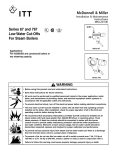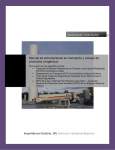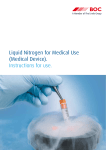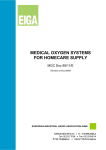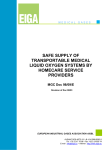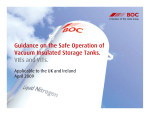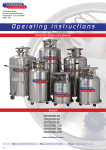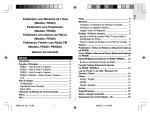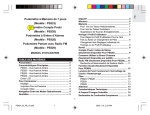Download User Manual Cryogenic Liquid Storage Vessel (VIT)
Transcript
User Manual Cryogenic Liquid Storage Vessel (VIT) BOC LTD CUSTOMER ENGINEERING SERVICES Note: Standard document. Not customer specific. Document No: JRUM072 Issue No. 3 Issue Date: May 08 Equipment Manual Contents 1. Introduction...................................................................................................................3 2. Safety Summary ............................................................................................................3 3. System Description........................................................................................................4 3.1. P&ID Diagram..................................................................................................................... 4 3.2. Equipment Description ....................................................................................................... 6 4. Operating Instructions..................................................................................................9 4.1. Normal Operation................................................................................................................ 9 4.2. Shutdown.............................................................................................................................. 9 4.3. To reduce Vessel Pressure................................................................................................. 10 4.4. Vessel Relief Valve or Bursting Disc Blows..................................................................... 10 4.5. Fault finding and Rectification......................................................................................... 12 4.6. VIT Filling.......................................................................................................................... 13 5. Routine Maintenance Instructions.............................................................................15 6. Daily Customer Checks For VIT Storage Vessel.......................................................15 Page 2 of 15 1. Introduction This User Manual details the operational and safety procedures for Cryogenic Liquid Storage Vessels (VITs) installed at customer works. VIT, Vacuum Insulated Tank is a historical BOC name for Cryogenic Liquid Storage Vessels utilised to supply liquid product to the customer process. BOC VIT's are double walled, vacuum insulated vessels designed for the storage of liquid oxygen, nitrogen and argon. The inner vessel containing the liquid is enclosed by an outer vessel to form a space between the two. This space is evacuated and filled with an insulant to ensure that heat inleak into the inner vessel is kept to a minimum. Normally VITs are used to supply liquid product to the customer’s process. The size and model of VIT installed are specified in the System User Manual together with all operating and safety device pressure settings. The VIT should not be put into service before the operator is familiar with the controls. 2. Safety Summary This User Manual will form part of the overall documentation package for the Cryogenic Liquid Storage and Distribution System. Gas Safety Data together with safety booklets is included in the Product Safety Manual. The Product Safety Manual and the System User Manual must be read by all operators before the system is put into service. Page 3 of 15 3. System Description 3.1. P&ID Diagram Page 4 of 15 No. Description No. Description S1 Jacketed Pressure Vessel BD18A-B Vessel Bursting Disc PSV2 Jacket Relief Valve V19 Level Gauge Equalising Valve V3 Vacuum Plug/Valve *V20 Gas Vent Valve V4 Trycock Valve PSV21 Liquid Lock Relief Valve V5 Gas Withdrawal/Instrument Supply PSV22 Liquid Lock Relief Valve V6 Three Way Valve PSV23 Liquid Lock Relief Valve V7 Liquid Withdrawal Valve PSV23A Liquid Lock Relief Valve (Auxiliary) V7A Liquid Withdrawal Valve (Auxiliary) V24 Liquid Pipeline Blowdown Valve V8 Level Gauge Valve (Gas Phase) V24A Liquid Pipeline Blowdown Valve (Auxiliary) V9 Gas Isolation Valve 25 Fill Coupling V10 Level Gauge Valve (Liquid Phase) PCV28 Pressure Raising Regulator V11 Liquid Isolation Valve *V29 Thermocouple Valve V12 Top Fill Valve *TC30 Thermocouple Gauge Head V13 Bottom Fill Valve *V31 Commissioning Valve V14 Liquid Level Gauge E32 Pressure Raising Vaporiser (No. Off & Type To Suit) V15 Pressure Gauge Valve PI33 Pressure Gauge F16 Vacuum Filter F36 Liquid Strainer PSV17 A-B Vessel Safety Relief Valve *BPV38 Back Pressure Valve *These valves are not fitted to all models of VITs Page 5 of 15 3.2. Equipment Description 3.2.1. VIT - Storage Vessel The VIT is a cryogenic pressure vessel made of stainless steel supported within a carbon steel vessel, the interspace being filled with a powder insulant and under vacuum. The outer vessel is of carbon steel protected against corrosion by a high quality paint finish. An outer vessel pressure relief device is incorporated in the top dome. Controls and instrumentation are mounted centrally at the front. Pressure vessel details are given on a plate mounted on the outer vessel and the liquid product is clearly labeled. All BOC storage vessels have non-interchangeable fill couplings so that it is impossible to deliver the wrong product into a vessel. Additionally all vessel valve numbers are standardised to avoid delivery driver confusion Note: VITs are strictly designed and manufactured to recognised national/international codes. Associated equipment is designed to the appropriate standards and authorised by BOC Design authority. There shall be no modification to the design of any part of the VIT system without written authorisation from BOC Limited. Records are kept of design, installation, maintenance and any modifications carried out. The VIT installation includes: • VIT: to store the liquid at the operating pressure. • Pressure Raising: to maintain the required operating pressure within the VIT (see section 3.2.3) 3.2.2. Control Piping and Instrumentation The VIT pipework configuration is shown in Section 3.1. VITs have top and bottom liquid fill connections. Each of these lines has two valves an operating and an isolation valve, (V9 and V12 top fill, V11 and V13 bottom fill). The isolation valves allow maintenance of the operation valves without interfering with the customer’s process. The isolation valves V9 and V11 are normally open as the pressure raising circuit is connected to them. Liquid lock relief valves, PSV 21 and PSV 22, are located between V9/V12 and V11/V13. These liquid lock relief valves relieve pressure build up due to trapped cryogenic liquid boiling off when the valves are isolated. Product supply for customer use is from V7. Product is withdrawn as liquid. Some vessels have two liquid withdrawal valves V7 located at the front of the vessel and V7A located at the rear of the vessel. Normally only one of these will be in use and the other blanked. But both could be used for separate process supplies. The valves fitted are bronze extended spindle globe type suitable for cryogenic service. Pipework is either stainless steel or copper. Page 6 of 15 3.2.3. Pressure Raising System As liquid is withdrawn for the main process, the vessel top gas pressure falls, to overcome this and maintain a constant vessel pressure a pressure raising circuit is installed. This consists of a pressure raising vaporiser together with a pressure raising regulator PCV 28. The pressure raising regulator (commonly known as a 'cash valve') senses the vessel top gas pressure and when it senses a drop in pressure it automatically allows a small quantity of product into the pressure raising vaporiser and thus raises the vessel pressure. The pressure raising regulator is adjusted as necessary by BOC to achieve the VITs normal working pressure. The pressure raising regulator is normally protected by a filter F36, both are normally fitted in the liquid phase but can be fitted in the gas phase. The pressure raising vaporiser(s) will consist of coiled aluminium or copper tube. Heat in leak from the surrounding atmosphere is used to vaporise the cryogenic liquid. The size and type of pressure raising vaporiser installed will be specified in the System User Manua. 3.2.4. Contents Indication A contents gauge is provided and is of the differential pressure type. The gauges are scaled in mm of water and calibration curves are provided to convert the readings to cubic metres of gas. The calibration curve for the specific model of VIT installed is provided in the user manual summary. The pressure tappings for the D.P. Gauge are either on independent connections on the vessel, or are taken off the main top gas and liquid connections (before or after V9 and V11). Note: If the connections are after (downstream) V9 and V11, isolation of these valves will render the D.P. Gauge in-operable and false readings will occur. Take care to ensure V9 and V11 are open when noting vessel contents on this type of vessel. Instrumental valves: • The liquid tapping (High Pressure) is connected to the gauge via V10. • The top gas tapping (Low Pressure) is connected to the gauge via V8. • An equalising valve V19 is provided to prevent damage to the gauge during filling operations and to aid gauge testing/calibration. The standard D.P. Gauge may be replaced by a D.P. Gauge complete with transmitter for connection to a BOC Teltank (Telemetry) system. On older vessels, contents indication may be by load cells and a weigh scale, there are no valves or pressure tappings associated with this type of contents indication. 3.2.5. Pressure Indication A Pressure Gauge (PI 33) is provided and indicates the pressure in Bar. Page 7 of 15 3.2.6. Pressure Relief System The VIT has two sets of pressure safety relief valves (PSV17A/17B) and bursting discs (BD18A/18B) located either side of a three way valve, V6. The three way valve may be a lever operated ball valve or a globe valve with handwheel. There is no 'off' position for this valve for safety reasons. At any time one safety valve and one bursting disc protect the vessel. The safety valve is the primary safety device and the bursting disc is the backup safety device. The bursting disc covers adverse circumstances and would not normally operate. The pressure relief valve works automatically to vent off excess pressure that may have built up in the VIT. This would only normally occur after the VIT had been shutdown for a prolonged period, which allows the cryogenic liquid to boil off and raise the vessel pressure. Although the relief valves are designed to function under cryogenic conditions there is a possibility that after lifting a valve may not re-seat. This would result in an unwanted fall in pressure within the vessel. In this instance the three-way valve may be operated to isolate the frozen relief valve, whilst bringing the back-up relief valve and bursting disc into service. Relief valve and bursting disc settings are specified in the System User Manual. 3.2.7. Instrument Supply Vaporiser The BOC process equipment installed often requires a gas supply to power instruments and pneumatically operated valves. In this instance vessel top gas from V5 is utilised and a copper coil (or copper or aluminum vaporiser) is provided to warm up the top gas prior to supplying the instruments. Page 8 of 15 4. Operating Instructions At the time of vessel commissioning the BOC engineer will give a short training session to the customers supervisors and operatives. If at any time the customer does not feel comfortable or confident to carry out any of BOC instructions he should phone BOC who will:• Talk through any problems. • Arrange additional training. A BOC engineer is available 24 hours a day, but out of normal hours, calls should be for emergencies only. The VIT’s normal operating pressure, relief valve and bursting disc settings are specified in The User Manual Summary and on a 'Pressure Plate' posted on the VIT, together with an instruction card. 4.1. Normal Operation During normal operation the valves shall be in the positions indicated below. Valve Number V5 V7 / 7A V9 V11 V12 V13 V6 Valve Description Gas Withdrawal / Instrument Supply Liquid Withdrawal Gas Isolating Liquid Isolating Top Fill Bottom Fill Three way valve to select alternative relief valve position Normal Operation Closed or open as applicable Open Open Open Closed Closed Move handle against stop in desired position 4.2. Shutdown During shutdown periods the valves shall be in the positions indicated below. Valve Number V5 V7 / 7A V9 V11 V12 V13 V6 Valve Description Gas Withdrawal / Instrument Supply Liquid Withdrawal Gas Isolating Liquid Isolating Top Fill Bottom Fill Three way valve to select alternative relief valve position Page 9 of 15 Shutdown Position Daily/Weekend Closed Long Term Closed Closed Closed Closed Closed Closed Move handle against stop in desired position Closed Closed Closed Closed Closed Move handle against stop in desired position 4.3. To reduce Vessel Pressure When the customers process does not require gas for a period of time, the vessel pressure will build up and eventually 'blow' the safety relief valves. Usually a back pressure valve (environmental valve) is fitted which vents excess pressure in a controlled manner. If the pressure vessel continues to rise then the liquid supply to pressure raising circuit should be isolated. Valve Number V5 V7 / 7A V9 V11 V12 V13 V6 Valve Description Gas Withdrawal / Instrument Supply Liquid Withdrawal Gas Isolating Liquid Isolating Top Fill Bottom Fill Three way valve to select alternative relief valve position Normal Operation Closed or open as applicable Open Open Closed Closed Closed Move handle against stop in desired position As soon as the vessel reaches its normal operating pressure the valves shall be returned to positions indicated in 4.1. 'Normal Operation'. If the valves are not returned to their 'normal' position the vessel pressure will fall below its normal operating pressure which could cause process problems. 4.4. Vessel Relief Valve or Bursting Disc Blows 4.4.1. In Case of Vessel Safety Relief Valve Blowing Close valve V11. This will isolate liquid supply to the pressure raising circuit. Gas will continue to vent from the safety relief valve until the vessel pressure falls by approximately 1 bar, the safety relief valve should then re-seat. If the safety relief valve does not re-seat, operate the three way valve to isolate the frozen relief valve and bring the back-up relief valve into service. Continue to operate with valve V11 closed until the vessel reaches its normal operating pressure. Then open V11 to resume normal operation. Note: If it is desired to reduce the vessel to its normal operating pressure quickly this can be done by venting gas to atmosphere via V20 or via the fill coupling from V9 and V12. Ensure that you stand to the side of the fill coupling. Do not leave vessel unattended whilst venting off gas. Page 10 of 15 4.4.2. In Case of Vessel Bursting Disc Blowing A Bursting Disc will 'Blow' for the following reasons:• Incorrect Operation (Below its pressure setting) • Due to malfunction of the bursting disc • Due to a sudden shock such as a safety relief valve lifting or liquid pumping into the vessel during a fill. • Correct Operation (At its pressure setting) • The vessel being overfilled, causing the pressure to rise quickly. • The vessel vacuum failing causing the vessel pressure to rise. • A pressure raising regulator failing causing the vessel pressure to rise. ACTION: Close valve V11. This will isolate liquid supply to the pressure raising circuit. Note: Do not leave vessel unattended whilst gas is venting. Change valve V6 to alternative relief position, after ensuring that vessel pressure is 1 bar below safety relief valves settings. Example: A VIT has a normal operating pressure of 2.5 Bar. The relief valves are set at 3.8 Bar and the bursting discs are set at 6.2 Bar. The vessel pressure should be allowed to fall to 3 Bar before operating V6. The appropriate settings are posted on the 'Pressure Plate' on the VIT. CAUTION: Notify BOC immediately so that a replacement disc can be fitted. Page 11 of 15 4.5. Fault finding and Rectification The following simple faults can be overcome by the customer. 4.5.1. Contents Gauge reading Zero There are three instrument valves associated with the contents gauge; • V19 Equalising Valve • V10 High Pressure Valve • V 8 Low Pressure Valve These valves are only normally operated by the driver during filling to prevent damage occurring to the gauge. ACTION: Follow this sequence to avoid damage to gauge: • Check V19 is closed. • If gauge still reads zero; • Open V19 • Open V 8 • Open V10 • Close V19 • If contents gauge connections are taken off after V9 and V11 check theses valve are open. • If gauge still reads zero contact BOC. 4.5.2. Leak of Gas or Liquid from Filling Coupling/Valves CAUTION: Take care! and wear appropriate personal protective equipment. Always stand to the side of the fill coupling at arms length. A filling valve V12 or V13 will leak for the following reasons; • damaged valve seat • moisture in the air has frozen forming ice under the valve seat preventing it from closing. ACTION: • Try to close the leaking valve, V12 or V13 as appropriate. • Do not over-tighten valves as this could cause damage to valve bodies. • If this does not work; • Close valves V9 and V11 • • This will shutdown the pressure raising circuit, but this will have no adverse effect for a short period of time. • Open valves V12 and V13 (adjust valves as necessary to control escape of gas). This will depressurise pipework and will take a few minutes. • Pour luke warm water over valve bodies of V12 or V13 as appropriate. • Close V12 and V13 • Open V9 and then V11 to re-pressurise pipework. If leak is not cured contact BOC. If the problem re-occurs notify BOC. Page 12 of 15 4.5.3. Pressure Safety Valve Stuck Open 4.5.3.1. Liquid Lock Safety Valves There are two liquid lock valves (Rego Valves) located between V9 and V12 on gas side and V11 and V13 on liquid side. These liquid lock safety valves would only normally 'blow off' during a shutdown. ACTION: If the valves 'blow off' during normal operation: • Close valves V9 and V11. This will shutdown the pressure raising circuit, but this will have no adverse effect for a short period. • At arms length; pour luke warm water over valve body, not in the open end. • If escape of gas persists contact BOC. • Open valves V9 and V11 to bring pressure raising back on stream. 4.5.3.2. Main Vessel safety Valves If the main vessel safety valve fails to re-seat follow procedure in section 4.4.1 4.6. VIT Filling After commissioning, subsequent filling of the VIT is controlled by the BOC driver. Step by step instructions are included in the Drivers Vehicle Instruction books issued by BOC Distribution Engineering. The driver is required to fill the VIT without disturbing the customers supply pressure or flow and without lifting safety valves or blowing bursting discs. On filling, the driver will report any defects to the supplying branch, using standard BOC asset defect report forms. 4.6.1. Fill Procedure The liquid tanker arrives on site and connects its filling hose to the VIT fill coupling, 25. The driver opens valves V12 and V13 and carries out the hose purge procedure as detailed in his standing instructions. The driver then starts his filling pump and proceeds to fill the VIT. Filling through valve V11 introduces liquid into the bottom of the tank which effectively increases the pressure, filling through valve V9 introduces the liquid into the top gas space which condenses the gas reducing the pressure. By controlling the flow through valves V11 and V9 the set pressure of the VIT can be maintained during filling. The driver continues to fill the VIT and monitors the pressure on the Pressure Gauge PI33. The vessel contents are displayed on the Contents Indicator LI14. When the liquid level in the vessel approaches the full mark, the driver opens the Trycock valve V4, which will vent gas to atmosphere. As the level reaches full, liquid will spill over and change the gas vent to liquid vent indicating to the driver that the vessel is full. The driver stops the pump, closes valves V12 and V13, vents and disconnects the filling hose from the vessel. Page 13 of 15 4.6.2. Customer Actions Before a Tanker Delivery • Make sure the area outside the fence and the access route is clear for tanker to enter and turn. • Check the level gauge on the vessel before filling begins. During a Tanker Delivery • Unauthorised personnel should be kept clear. • Make sure that people do not smoke or use naked flames within 5 metres of tankers making oxygen deliveries. • Avoid entering vapour clouds in the event of spillage. After a Tanker Delivery • Check the level gauge to see that filling is complete. • Agree the quantity on the delivery note with the tanker driver. • Make sure the dust cap has been replaced on the filling connection. • After up to one or two hours check that there is no leakage of liquid from valves V12 and V13. Hand tighten any valve that is leaking. (See section 4.5.2) Emergency During Delivery If, in the unlikely event that during the course of delivery anything should prevent the driver from completing his duties, tanker discharge may be stopped by - pressing RED 'STOP' BUTTON located in the control panel at the rear of the tanker and/or - stopping the vehicle engine using the cut off in the driver's cab. Then please telephone BOC at the number shown on the hazard warning panel sign on the vehicles. Page 14 of 15 5. Routine Maintenance Instructions A full overview of BOC’s maintenance system and the requirements of the Pressure Systems Safety Regulations 2000 SI 128 is given in the System User Manual provided. Maintenance and examination requirements are set out in the appropriate BOC Planned Preventative Maintenance (PPM) schedule or Written Scheme of Examination (WSE), in accordance with good engineering practice and the Pressure Systems Safety Regulations. 6. Daily Customer Checks For VIT Storage Vessel ACTION: The user should check the following items on a daily basis: Step Action 1 Vessel contents are adequate for expected use. 2 Pressure gauge is indicating pressure and is within the normal operating range. 3 The installation for general damage/and deterioration. 4 The installation for leaks. 5 That all safety notices are in place, legible and not obstructed from view. 6 The vicinity of the VIT for anything introduced since last inspection which could affect the safe operation of the system. Consult BOC if doubt exists. 7 Ensure that the VIT compound is kept clear at all times. Make sure there is nothing that will burn, eg. paper, cardboard boxes, rags, weed growth. Additionally the area adjacent to VIE compound should be kept clear of combustible materials for a distance of; • 5m for Oxygen Vessels up to 17,500 litres • 8m for Oxygen Vessels up to 175,000 litres • 3m for Nitrogen and Argon Vessels Note: For more information see the Technical Data Sheets in the Product Safety Manual provided. 8 Ensure that the area adjacent to the VIT and the site access route for the BOC delivery tanker are kept clear. Page 15 of 15















